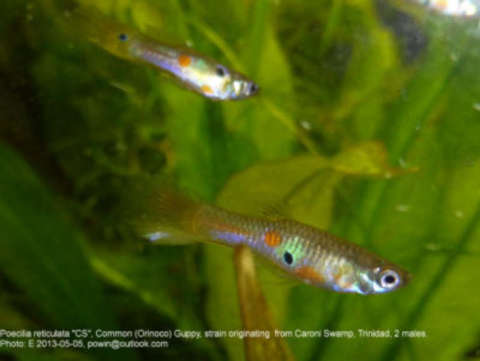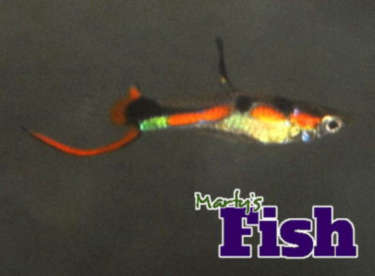The Differences Between Guppies & Endlers

At first glance pure or N class Endlers look very much like wild guppies. With small spots of black and dashes of color it is easy to understand why many people get Endlers and wild Guppies confused.
Coloration
Endlers usually exhibit much brighter and more metallic colors than do wild Guppies. The bright metallic green coloration is what first caught the attention of John Endler when he re-discovered them in their native habitat in Venezuela.
Another thing that can help differentiate a Guppy from an Endler is the body color of the females. Guppies tend to have a silvery colored body and Endlers tend to be more golden. This does not always work 100% of the time as environmental factors can have a huge effect on the coloration of both Guppies and Endlers.
Size
Pure Endlers are approximately the same size as their wild Guppy counterpart. This size is usually quite a bit smaller than domesticated Fancy Guppies. Pure Endler females and Guppy females are very similar in size.
Size can sometimes vary as with any animal because runts or dwarfs can turn up from time to time and there can even be giants in the Endler & Guppy world. We once had a female N Class Orchid Endler that grew over 3″ long. She was a great producer for over two years. We also produced a line of dwarf Orchid Endlers for a time. The tiny males seldom grew to over 1/2″ in length. Unfortunately there was no interest in the small males so we discontinued the project.
Swordtails

Male Endlers often appear to have a coloration in the caudal fin rays that give the appearance of a swordtail, this coloration usually does not extend past the colorless portion of the caudal fin however with controlled breeding the “sword” can extend as much as 1/2″ past the caudal fin.
When the sword extends past the caudal fin on an Endler the sword is very thin and delicate. Guppies that have a swordtail tend to have a much thicker swordtail.
Body Shape
Guppies also have a thicker caudal peduncle than do pure Endlers. This thicker caudal peduncle may give Guppies a stockier appearance than pure Endlers. The caudal peduncle tends to be somewhat opaque whereas the caudal peduncle tends to be more transparent.
The Gonopodium
The shape of the Gonopodium (sex organ) on male Guppies and male Endlers are quite different with the Guppy Gonopodium being thick and the Endler Gonopodium being thin. The Gonopodium on Guppies several hooks to hold onto the female with and Endlers only have one hook.
Is There A Way To Be Absolutely Sure Of What I Have?
Short of scientific testing, the reality is no. While careful measures have been taken to make sure there are pure Endler strains available, they are only pure so long as they have never been exposed to Guppies.
If you want to make sure you get pure N Class Endlers you must buy your Endlers from a reliable source and that breeder must have bought his Endlers from a reliable source. Even that may not be enough because if you were to go to Venezuela today and pick up your own wild Endlers (if you could find them) it would be likely that they will have been exposed to the local wild Guppy population.
Endler Classification System (ECS)
One method that was developed early on to help maintain a source of pure Endlers is the Endler Classification System.
N Class Endlers
Any Endlers Livebearer (and progeny) that can be shown to have originated from their native waters in Venezuela and has not had their genetics contaminated by hybridization.
P Class Endlers: (Appears to be Pure But Has No documentation)
Any fish of unknown origin but appearing to be an Endlers Livebearer based on the characteristics of size, shape and color.
This is the classification that most Endlers Livebearers that are available today fall under. Because it is so difficult to document the origination of the Endler’s to those that came directly from Venezuela the majority of the “pure” stock kept by hobbyists today are considered Class P.
K Class Endlers: (Hybrid Strain)
The progeny of any Endlers Live-bearer crossed with any other live-bearer or any hybrid strain. Most Endlers that come from pet shops or fish stores are likely to be K Class Endlers.
Even if they came into the pet shop as pure strain Endlers few of them are ever documented (making them P Class) and few pet stores have the ability to make sure that the Endlers never come in contact with Guppies.
Hybrids: Guppies or Endlers?
So if you cross a Guppy with an Endler, is it a Guppy or is it an Endler? It’s actually both and neither; a hybrid. So why are some of the hybrids called Endlers and some called Guppies.
Some hobbyists name all Guppy/Endler hybrids as Guppies in an attempt to preserve the pure bloodlines of Endlers. This can be somewhat confusing as some Guppy/Endler hybrids look nearly identical to pure Endlers and some look much closer to Guppies.
The fact is that the breeder gets to choose whatever they want to call them, Guppies or Endlers. For the most part most breeders choose a name that the strain most closely represents. If the males are smaller and dainty then the breeder will likely call it an Endler. If the caudal fin is closer to that of a Fancy Guppy then the breeder is likely to call it a Guppy.
The Multicolored Tiger Endler for example is a fairly large bodied Endler more closely appearing as a Guppy however the metallic coloration gives it a more Endler look.
If I were the original breeder of the beautiful strain I would have been more inclined to call it a Guppy. Maybe because a similar Endler was produced, the Tiger Endler, first the breeder chose to call them Endlers because of the close appearance to that beautiful strain.
One thing is for certain, the hybridization of Endlers and Guppies has only begun and we have lots of beautiful strains to look forward to. There are some hobbyists that believe that over time Guppies an Endlers are destine to become one due to uncontrolled hybridization. With the exception of those few that maintain pure lines this may very well be the eventual fate of Guppies and Endlers.

Recently, I changed from keeping Neon Tetras to keeping Endlers. I suspect they are not pure N class. I have two ten gallon tanks and one 6 gallon. My intention is to breed them. I will split the males from the females in the ten gallon tanks and use the six gallon for breeding.
All the tanks have hang on back filters, heaters made for the tanks that keep the two ten gallons at 26 degrees and an adjustable heater in the smaller six gallon. I have read, on your site, on your site, that if I keep the breeding tank at a higher temperature, say 28 degrees, I should get mostly males.
As a substrate I have small size black gravel about one and a half inches deep. Each tank has three sides covered externally with black A4 card. I think the dark appearance looks better than those awful see seascape things. And, in addition it sets off the colours of the fish nicely.
After cycling the tanks for six weeks I started with two males and five females.
Unfortunately, one of the males was sickly and died after a month. I can find no reason for it’s sad demise as all the other fish are fine.
After a month I got a drop of about 16 fry and a month later another drop of about 30.
My currant breeding male of choice is a beautiful male I call ‘Paint Pallet’ due to his lovely dark blue, light blue, orange and black colouration with a top and bottom sword tail of orange. I will send a picture of this fish so that you can, if you have time, let me know what your opinions are as to it’s genetic makeup.
One of the biggest problems I have had is what I call ‘fluff’ mould. It is like a smaller version of dandelion seeds and can end up covering absolutely everything but the fish. The fish don’t seem to mind it but it looks awful. Fortunately I have come across a treatment for this and that got rid of that problem.
I suspect I was over feeding. It is difficult to know how much to feed a tank of fry of varying ages.
I have led lighting that is submersible and can be adjusted in colour and brightness. I vary the lighting to try and match a tropical days light cycle.
Your site has been an inspiration for me and is the first place I come for answers to ant queries I may have.
Thanks for all your work and sharing it. I am absolutely sure that many people have, just like me, benefited from your hard work.
Thanks for making me aware in the first place of these fantastic little fish.
May you go from success to greater success.